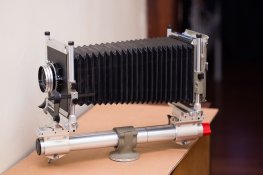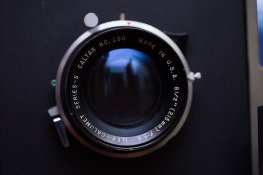That's all hunky-dorie if you are always shooting with a tripod and shutter speed doesn't matter. But if you think you can only shoot at a certain aperture and you end up missing a shot, then the 'logic' fails miserably.
Sparky, you do in fact have a good point there. With hindsight after reading your response, I do think I could have elaborated slightly more. Which would have possibly answered the question that I answered, more completely to the questioner.
With regard to LF photography, I try to always use the optimum aperture I am able to use under the circumstances I am shooting. Which, and within reason, is generally between f/16 to f/22 and, as mentioned, the camera is almost always on a tripod.
The exception is my Razzle 4x5” camera. Which is a converted Polaroid camera with a longer focal length lens of 150mm compared to the original 127mm. With this camera/lens combination, I have rarely used a tripod with this camera. One time I did was to re-set the cam for focusing, then taking an exposure to confirm that the focus was correct before demounting said camera from the tripod.
This longer length lens does throw up some interesting side effects, one of which is coverage. The lens itself is a Fujinon f/6.3 150mm. Generally I try to use f/11, however, when using a slower film like Ilford FP4+, I mostly use f/8. Apart from the fact the depth of acceptable focus is sort of razor thin, there is the coverage aspect.
Coverage can be greatly affected by close focusing when your fixed body has another lens grafted on, which in the case of my converted Polaroid camera is an issue. When taking portraiture pictures, I generally work on a bust type of portrait, meaning I need to be reasonably close to the subject. In this instance usually I’m between 1.2m to 2m distance and running close to maximum bellows extension.
I have been quite successful with this camera/lens combination for doing hand held portraiture as I have described. But the trade-off is lack of coverage when either wide open, or close to wide open. At an aperture of f/8, and running close to maximum extension, I never get enough coverage. Due to the ability to crop in the enlarger, it really isn’t too much of an issue, so I don’t have any problems.
As a matter of interest, at f/32 the coverage is about there, at f/45 – f/64 I certainly have full coverage, but then I wouldn’t be able to use this camera hand held, which is what it’s all about.
I have and do use apertures that are outside the optimal, or close to optimal aperture, as defined by the manufacturers themselves; there is nothing wrong with doing that. But in the main, if one is using a sheet film camera, then generally, quality of the image is what most practitioners I have ever met are after. As for longer focal lengths not being too much of an issue with 4x5” cameras, that is about right. However, if you use a Telephoto lens, coverage is completely different and markedly less. More so if one uses one of these lenses for portraiture; you should see the outtakes I had when I started using my 400T lens for portraiture on my 4x5” cameras.
I did a web search and was surprised to find that Dean Jones, the inventer/builder of the Razzle cameras, still had clips up; he passed away in December 2014. Living in the same city as Dean, made it pretty easy to have a face to face order for my camera. Also made it easy to hand over the lens I picked for it. I have the same lens always sitting in my folded up Shen Hoa 4x5” camera. First time I have ever had two identical lenses and used them continuously on two cameras.
This is a link to one of dean’s clips, the first camera he shows is almost identical to the one he built for me. If you think that is as easy as it looks, rest assured it is that easy. Even better when loaded with a Grafmatic back and six sheets of film.
Mick.






